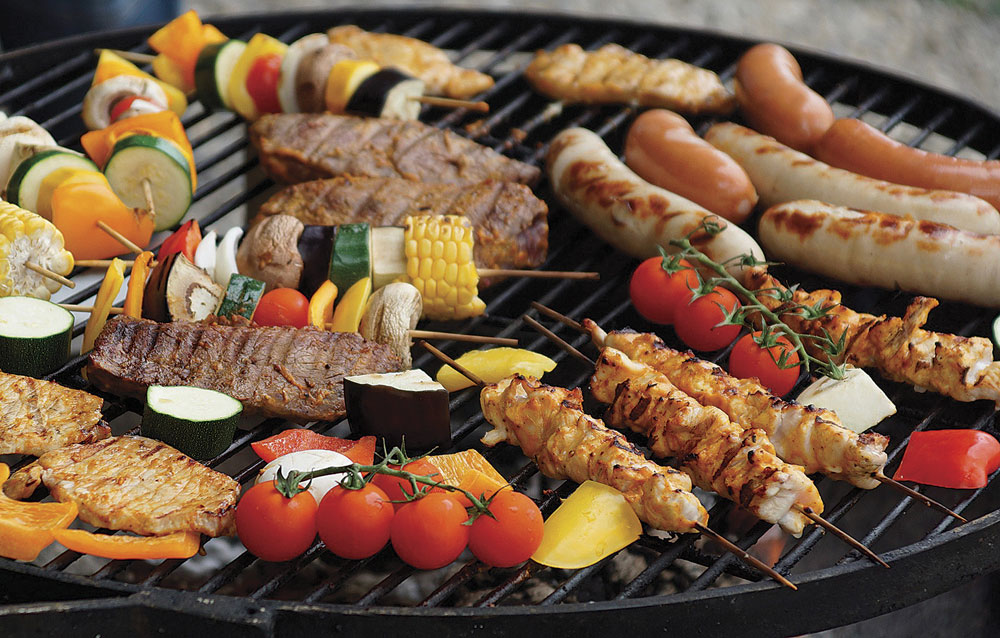Grilled vegetables and fruits have a flavor boost
Fruits and vegetables add color, texture, flavor, nutrition to menus without adding a lot of calories

Adding some fruit and vegetables to your grill is a good idea on many levels. (Photo courtesy of Pixabay) Submitted Photo
“Mom, this fruit tastes extra sweet!” my daughter remarked as she sampled a slice of grilled pineapple along with a bite of grilled ham. She was about 11 at the time.
I tasted a piece of pineapple and nodded in agreement.
“Why does the pineapple taste so sweet?” she asked.
“Fruit naturally contains sugar,” I explained. “The heat of the grill causes the sugar to caramelize and taste even sweeter to us.”
“Grilling also adds a smoky flavor to fruits,” I added.
I appreciated her interest.
I thought she was attempting to inspire a column. Turns out, I was correct.
“I think you should write a column about grilling fruits and vegetables,” she suggested as she reached for another slice of pineapple.
“That’s a good idea,” I said.
Unfortunately, we cannot grow fresh pineapple in the Midwest for our grilling menu. In many grocery stores, pineapple has its peak season in spring and summer.
Most people shortchange themselves on fruits and vegetables, especially dark green and dark gold/orange ones. Eating more fruits and vegetables can reduce your risk for cancer, heart disease and diabetes, and can help with weight management.
Fruits and vegetables are high in volume but low in calories because most types of fruits and vegetables are more than 90% water. Consuming adequate water whether through beverages or food is essential for maintaining the function of our body.
Adding some fruits and vegetables to your grill is a good idea on many levels. Fruits and vegetables add color, texture, flavor and nutrition without adding a lot of calories.
Fruits and vegetables add fiber to your diet, a component lacking for many adults and children. Many fruits and vegetables are notable sources of vitamins A and C, along with phytochemicals (natural plant chemicals).
As we proceed into summer months, different vegetables and fruits come into season. When fresh fruits and vegetables are in season, they are at their best quality and, usually, lowest price in grocery stores.
Adding some variety to your meal preparation options can inspire your family to try some new foods. Add some vegetables to your grilling menu with these food safety and preparation tips:
Rinse fruits and vegetables under running water.
Preheat your grill. Cook small items using a grilling pan with slots or small holes.
Cut vegetables into large, flat pieces of even thickness throughout each slice. You can cut them into smaller pieces after cooking.
Prepare bell peppers by cutting off the top and bottom of the pepper. Remove the core and then cut the pepper in half from top to bottom. (This way you end up with two flat rectangles that are grilled skin side down.)
Add flavor to vegetables with olive oil (or another type of oil) and your favorite seasonings. Lay them in a single layer on a cookie sheet, brush with oil and season. Turn them over and repeat on the other side.
Use marinades to add flavor. Be aware that sugar-based marinades cause the exterior of the vegetables to blacken.
Use moist and dry heat to cook your vegetables. Grill the vegetables until they have grill markings on both sides. Remove them from the grill and place into a bowl or pot. Cover tightly with plastic wrap to prevent the steam from escaping for five to 10 minutes. This will finish the cooking process of the vegetables without drying them out.
Maintain food safety. Vegetables do not need to be temperature-checked after cooking; however, fresh cut and cooked vegetables are perishable. Keep cooked food hot (above 140 F) and serve cut produce in containers nested over ice-filled containers.
If you make kabobs with meat and vegetables, be sure the meat reaches a safe internal temperature. Cook chicken to an internal temperature of 165 F. If you serve hamburgers with your grilled veggies, be sure the ground beef reaches 160 F.
Instead of a recipe, this week I provide some approximate grilling times for vegetables. You might be surprised that romaine lettuce can be grilled briefly to give it a smoky flavor. Many of these vegetables can be grown in your garden, so keep this in mind for your home-grown veggies or other locally grown vegetables later this summer.
See the NDSU Extension publications “Try Adding Some Fruits and Vegetables to Your Grilling Menu” (FN1856) and “Grill Something Different” (FN1420) for more tips. Visit www.ag.ndsu.edu/food and check out the food preparation information.
Remember, the cooking time will depend on the heat of your grill.
Asparagus: six to eight minutes
Bell peppers: whole, 10 to 12 minutes; halved or quartered, six to eight minutes
Corn on the cob: peeled, 10 to 12 minutes; in husk, 25 to 30 minutes
Green beans: eight to 10 minutes
Green onions: whole, three to four minutes
Onions: whole, 45 to 50 minutes; halved, 35 to 40 minutes
Mushrooms: shitake or button, eight to 10 minutes; portobello, 12 to 15 minutes
Potatoes: new, halved, 20 to 25 minutes; whole potatoes, 45 minutes
Romaine lettuce: whole head, one to two minutes
Summer squash (yellow squash, zucchini): 1/2-inch slices, six to eight minutes
Sweet potatoes: 1/4-inch slides, eight to 10 minutes
Online: For more Prairie Fare columns: www.ag.ndsu.edu/news/columns/prairie-fare/




